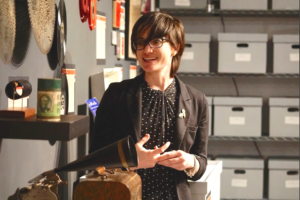By Lara Becker
Reviews Editor

Radiating from an early 1900s record player were the vibrations of a jazz melody that brought the room to a lulled hush. Hanging on the walls were 78s, 45s and vinyls of all shapes and sizes.
A grant from the Mercer County Cultural Heritage Program aided the College’s effort to collect these artifacts, which gave way to the first guided tour of “In The Groove: A Century of Sound” on Sunday, March 31 at 1:30 p.m.
Sarnoff Collection curator Florencia Pierri coordinates the annual rotation of exhibits in Roscoe West, and when the time came this year, she settled on the idea of sound technology.
“The students came here and had a hands-on tour of artifacts — they got to play old records.” Pierri said. “We’re doing an oral history project and over the summer we’re putting out a call for student performers. We’re putting together something for electronic music for students.”
Pierri took students and interested guests on a tour of sound from 1877, when the first Edison cylinder was created, to 1978, which brought the first computer-generated music program.
The journey of 100 years through sound began with Thomas Edison’s tin cylinder, which was birthed in his Menlo Park laboratory in 1876. That same year, Alexander Graham Bell began working on the telephone.
Bell’s telephone soon led Edison to telegraphy, which would allow voices and sounds to be played back and heard again. He was looking for a way to record voices heard on a telephone in order to keep a permanent record of the conversation.
It all began with his foil-wrapped cylinder for dictation records, which then led to a wax cylinder for music recording and music box discs in the late 1880s. By 1902, Edison had finally found a way to mass produce his cylinder, making it the best recorded sound device on the market at the time.
German-born inventor Emile Berliner crafted a way to pump out recordings of these sounds by the hundreds. He invented the flat disk where sound wires were pressed into one hand-held record.
Columbia Records and the Radio Corporation of America engineers were integral in the mass-production of these early phonographs and records, becoming giants in sound modernization.
As music history progressed, the first electronic instrument was created and was named the Theremin for Russian inventor Léon Theremin. It is a proximity sensor that transfers the conduction from one’s body into sound when hands are waved next to it.
The Theremin was the first sound synthesizer, leading to the technology we have today such as computer-generated music and electronic synthesizers.
Timothy Ryan, a sophomore journalism and English double major, attended the tour. He went from knowing next to nothing about the history of music to being fascinated by these innovators by the end of the tour.
“I’m used to just listening to digital music, or whatever is on my computer or on my phone,” said Ryan. “It was very interesting seeing the ingenuity of music over the years from the cylinder to the flat disk to the records.”
Pierri was grateful to visitors for joining the first tour of the new exhibit, which she explained was a test run for the grand opening of the installment in April.
“I think it was incredibly interesting learning about the concrete history of music, especially over a century, and seeing how far we’ve come in that century,” he said.







